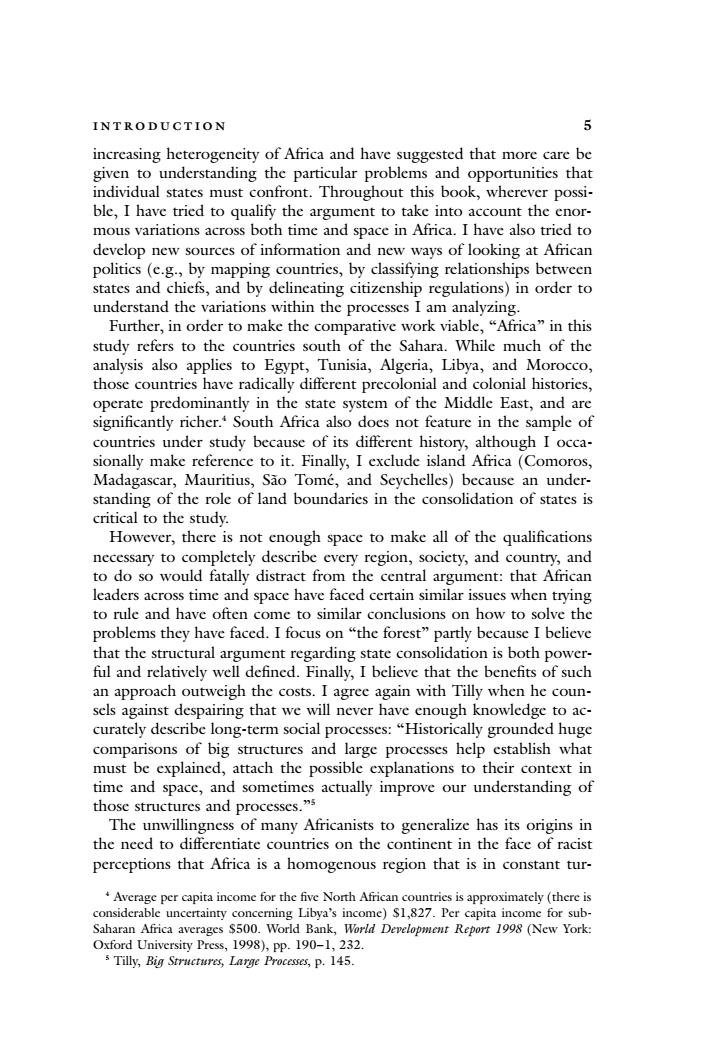正在加载图片...

INTRODUCTION 5 increasing heterogeneity of Africa and have suggested that more care be given to understanding the particular problems and opportunities that individual states must confront.Throughout this book,wherever possi- ble,I have tried to qualify the argument to take into account the enor- mous variations across both time and space in Africa.I have also tried to develop new sources of information and new ways of looking at African politics(c.g.,by mapping countries,by classifying relationships between states and chiefs,and by delincating citizenship regulations)in order to understand the variations within the processes I am analyzing. Further,in order to make the comparative work viable,"Africa"in this study refers to the countries south of the Sahara.While much of the analysis also applies to Egypt,Tunisia,Algeria,Libya,and Morocco, those countries have radically different precolonial and colonial historics, operate predominantly in the state system of the Middle East,and are significantly richer.'South Africa also does not feature in the sample of countries under study because of its different history,although I occa- sionally make reference to it.Finally,I exclude island Africa (Comoros, Madagascar,Mauritius,Sao Tome,and Seychelles)because an under- standing of the role of land boundaries in the consolidation of states is critical to the study. However,there is not enough space to make all of the qualifications necessary to completely describe every region,socicty,and country,and to do so would fatally distract from the central argument:that African leaders across time and space have faced certain similar issues when trying to rule and have often come to similar conclusions on how to solve the problems they have faced.I focus on "the forest"partly because I believe that the structural argument regarding state consolidation is both power- ful and relatively well defined.Finally,I believe that the benefits of such an approach outweigh the costs.I agree again with Tilly when he coun- sels against despairing that we will never have enough knowledge to ac- curately describe long-term social processes:"Historically grounded huge comparisons of big structures and large processes help establish what must be explained,attach the possible explanations to their context in time and space,and sometimes actually improve our understanding of those structures and processes."s The unwillingness of many Africanists to generalize has its origins in the need to differentiate countries on the continent in the face of racist perceptions that Africa is a homogenous region that is in constant tur- +Average per capita income for the five North African countries is approximately (there is considerable uncertainty concerning Libya's income)$1,827.Per capita income for sub- Saharan Africa averages $500.World Bank,World Development Report 1998 (New York: Oxford University Press,1998),pp.190-1,232. s Tilly,Big Structures,Large Processes,p.145.INTRODUCTION 5 increasing heterogeneity of Africa and have suggested that more care be given to understanding the particular problems and opportunities that individual states must confront. Throughout this book, wherever possible, I have tried to qualify the argument to take into account the enormous variations across both time and space in Africa. I have also tried to develop new sources of information and new ways of looking at African politics (e.g., by mapping countries, by classifying relationships between states and chiefs, and by delineating citizenship regulations) in order to understand the variations within the processes I am analyzing. Further, in order to make the comparative work viable, “Africa” in this study refers to the countries south of the Sahara. While much of the analysis also applies to Egypt, Tunisia, Algeria, Libya, and Morocco, those countries have radically different precolonial and colonial histories, operate predominantly in the state system of the Middle East, and are significantly richer. 4 South Africa also does not feature in the sample of countries under study because of its different history, although I occasionally make reference to it. Finally, I exclude island Africa (Comoros, Madagascar, Mauritius, S˜ao Tome, and Seychelles) because an under ´ - standing of the role of land boundaries in the consolidation of states is critical to the study. However, there is not enough space to make all of the qualifications necessary to completely describe every region, society, and country, and to do so would fatally distract from the central argument: that African leaders across time and space have faced certain similar issues when trying to rule and have often come to similar conclusions on how to solve the problems they have faced. I focus on “the forest” partly because I believe that the structural argument regarding state consolidation is both powerful and relatively well defined. Finally, I believe that the benefits of such an approach outweigh the costs. I agree again with Tilly when he counsels against despairing that we will never have enough knowledge to accurately describe long-term social processes: “Historically grounded huge comparisons of big structures and large processes help establish what must be explained, attach the possible explanations to their context in time and space, and sometimes actually improve our understanding of those structures and processes.”5 The unwillingness of many Africanists to generalize has its origins in the need to differentiate countries on the continent in the face of racist perceptions that Africa is a homogenous region that is in constant tur- 4 Average per capita income for the five North African countries is approximately (there is considerable uncertainty concerning Libya’s income) $1,827. Per capita income for subSaharan Africa averages $500. World Bank, World Development Report 1998 (New York: Oxford University Press, 1998), pp. 190–1, 232. 5 Tilly, Big Structures, Large Processes, p. 145